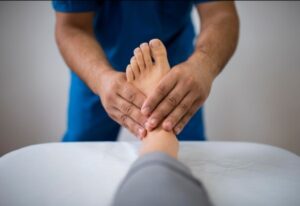Although an ankle sprain can be a painful and incapacitating injury, people can effectively manage their rehabilitation and avoid further injuries with the right patient education and adherence to an organized home exercise program. We’ll explore the value of patient education, the elements of a successful at-home workout regimen, and useful advice for a successful recovery in this extensive book.

Understanding Ankle Sprains:
Ankle sprains are caused by a stretching or tearing of the ligaments supporting the ankle joint, sometimes as a result of abrupt foot twisting or rolling. Pain, bruising, swelling, and trouble bearing weight on the injured ankle might result from this. People must be aware of the structure of the ankle joint, the mode of damage, and the possible long-term effects of sprains that may not be addressed, such as persistent instability or repeated injuries.

The importance of patient education cannot be overstated in the treatment of ankle sprains. Patients take an active role in their own recovery when they are equipped with information regarding their injury, available treatments, and the rehabilitation process. Topics like R.I.C.E. (Rest, Ice, Compression, Elevation), the significance of prompt mobilisation, appropriate footwear, and warning indicators of problems should all be included in education. Patients should also be informed about the ways in which a regimented home exercise programme can aid in the promotion of healing and the restoration of function.

A Home Exercise Program’s Components:
A well-thought-out at-home workout regimen is essential to the recovery from ankle sprains. Usually, it is made up of three primary parts:
1. Exercises for Range of Motion:
Mild exercises for range of motion in the ankles can help ease stiffness and increase joint mobility. Towel stretches, ankle alphabet exercises, and ankle circles are a few examples. These exercises should be done by patients several times a day, with the range of motion being gradually increased as tolerated.
2. Exercises for Strengthening:
For stability and injury prevention, it is essential to strengthen the muscles surrounding the ankle joint. workouts that target the calf muscles, peroneals, and intrinsic foot muscles include calf lifts, toe taps, and resistance band workouts. As strength increases, patients should concentrate on progressively increasing resistance and repetitions.
3. Balance and Proprioception Training:
Balance and proprioception exercises help restore neuromuscular control and enhance joint stability. These may include single-leg stance, balance board exercises, and proprioceptive drills such as standing on uneven surfaces. Patients should aim to challenge their balance in various positions and progress to more dynamic activities over time.

Advice for a Successful Rehab:
Patients should adhere to the following advice to enhance the efficacy of a home exercise programme for ankle sprains:
Maintaining consistency is essential. Regularly carry out the exercises that your physiotherapist or healthcare practitioner prescribes.
Pay attention to your body. When performing exercises, be aware of any pain or discomfort and modify your technique or intensity accordingly.

Proceed gradually:
Exercise gently at first, then progressively increase the duration, difficulty, and intensity as you are able.
Make use of suitable form:
To guarantee ideal muscle activation and injury avoidance, concentrate on using correct technique.
Remain inspired:
Set attainable objectives, monitor your development, and acknowledge your accomplishments as you go.

In conclusion,
two crucial elements of the recovery process for ankle sprains are patient education and a coordinated home exercise regimen. Healthcare professionals can promote optimal outcomes and lower the likelihood of recurring injuries by arming people with information and enabling them to actively participate in their recovery. People can restore strength, mobility, and trust in their ankle joint with perseverance, patience, and dedication. This will enable them to resume their regular activities and sports with a decreased risk of sprains in the future.


1 thought on “How to Utilize Ankle Sprain Patient Education and At-Home Exercise Reg”